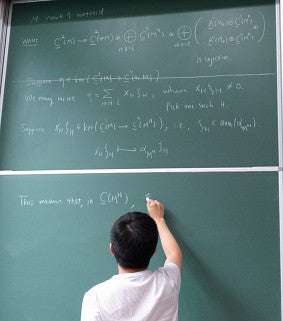
The latest research in combinatorial algebraic geometry coming out of the University of Oregon’s Math Department doesn’t often make headlines. But one big Math Moment that happens every four years does. Those who’ve seen Good Will Hunting may recall the MIT math professor character played by Stellan Skarsgård and the academic award that gave him his swagger – the Fields Medal.
Akin to the Nobel Prize for mathematics, the Fields Medal is given out every four years to a handful of wunderkinder – recipients must be under 40 – “to recognize outstanding mathematical achievement for existing work and for the promise of future achievement.”
One of the 2022 Fields medals went to June Huh, a Princeton mathematician with close ties to the UO’s own Nicholas Proudfoot. The math professor and department head is part of an official, NSF-funded research group that includes Huh, and has been a coauthor on several of the proofs for which Huh received the medal. The deeply collaborative nature of mathematical research allows Proudfoot to also feel a sense of pride in the recognition for Huh and their shared work.
“Every one of my works could not have been done without the help and influence of my collaborators,” Huh said in a video about winning the award. “Being part of a giant network of very good people gives me the freedom that I could not imagine before I became a mathematician. On clear days, I can see that I am a small and simple part of a big and complex ancient structure, like a mushroom sprouted from a giant underground fungal network. In some mysterious way, we are connected to each other, and we grow from that connection.”
Proudfoot is ebullient about Huh’s award and the parts of the work he and others helped prove, one of which is a paper titled Singular Hodge theory for combinatorial geometries.
“June is a brilliant mathematician who's done a lot of amazing stuff, and I feel honored to have played a role in one of the many accomplishments for which he was recognized,” he said.
Proudfoot first met Huh when the former invited him to the UO campus in 2015 to give lectures for graduate students and postdocs as part of a series called WARTHOG (Workshop on Algebra and Representation Theory Held on Oregonian Grounds) which is co-organized by Proudfoot and fellow UO Professor Ben Elias. After that, Proudfoot and Huh traveled together to Norway and Korea, Huh’s home country, to give lectures and work together on mathematics.
Today, Proudfoot and Huh work together on the intersection of combinatorics and algebraic geometry, with the help of a Focused Research Group grant from the National Science Foundation that also includes Melody Chan of Brown and Sam Payne of University of Texas.
Their work is focused on solving open problems related to matroids, a kind of geometric structure. Prior to the pandemic, mathematicians like Proudfoot often got together and sat in front of a blackboard all day, testing out ideas. In between meetings, working together has always meant flurries of long emails punctuated by months of silence. That hasn’t changed, but since this grant was funded in 2021, meetings now happen on Zoom instead of in front of the board.
It’s very much understood among their colleagues that publications in mathematics research represent more than the sum of the people whose names appear on them or of the words on the page, explained Hal Sadofsky, an associate professor of mathematics and the College of Arts and Sciences divisional dean of natural sciences at the UO.
“We build mathematics over time on top of the work of other mathematicians,” said Sadofsky. “Every time you see new mathematics that uses a piece of something you’ve helped to do, you feel a little jot of satisfaction regardless of whether your name is in that paper.”
It’s an even greater feeling when a colleague wins a major award like this, Sadofsky said. “The Fields Medal goes to a mathematician, but it is really about the mathematics they have done. For one of our faculty to have been a key player in part of that is a great thing!”
“In the experimental sciences, you have these multi-author papers, and author positions mean a lot,” said Proudfoot, who noted the order is determined by factors like the amount someone contributed and their seniority. “Math doesn’t have that at all. Our papers list authors alphabetically.”
The research environment Proudfoot describes as characteristic of the mathematics field is one in many ways more akin to humanities than science.
“Math is often classified as a science, but we're kind of the oddball science in that we don't study physical things. We're not using any equipment; we don’t do physical experiments,” said Proudfoot. “In some sense, I feel like culturally we're much closer to English than to Biology. We’re working on things, not with any application in mind, just because it's interesting and beautiful in its own internal structure.”
For those interested, a more accessible account of the findings of one of Huh and Proudfoot’s most important collaborations is described in a popular scientific exposition paper written by another mathematician and shared along with the Fields announcement.
-By Anna Glavash Miller, College of Arts and Sciences
